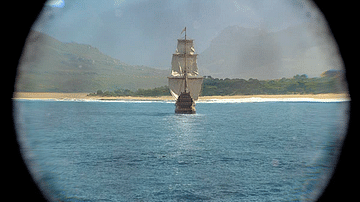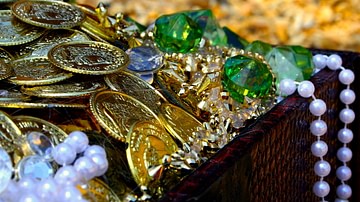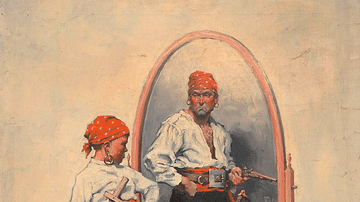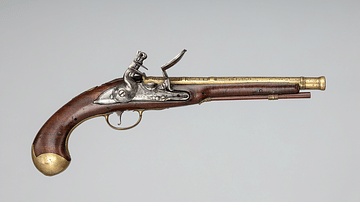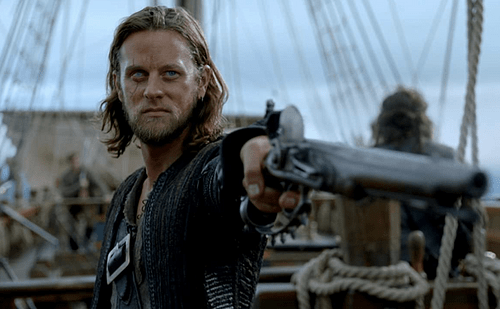
Edward 'Ned' Low was an English pirate active in the Caribbean and eastern Atlantic from 1721 to 1724 during the Golden Age of Piracy (1690-1730). Probably the most sadistic and cruelest of all pirate captains, Low was said to have frequently tortured and mutilated prisoners, cutting off lips and ears, ripping out beating hearts, and then making other prisoners eat such gruesome morsels.
Captain Low was successful over a brutal four years of piracy, capturing ships from the Bay of Honduras to Nantucket to the Azores. Low’s comeuppance came from his own crew who mutinied and marooned him. Edward Low likely died in 1724 but exactly how or where is not certain.
Mutiny & Partnership with Lowther
Little is known of Low’s early life except that he was English, born in Westminster, London. He was known for his cheating at gambling as a child, and his brother was equally notorious as the first child thief to use the ploy of being carried in a basket in a crowd and from there stealing the expensive wigs of passing gentry. Edward went to sea at a young age and then ended up in Boston where he married, had a child, and worked for a time in a company producing rigging. His wife died prematurely, and this drove Low to despair and perhaps to a life of crime. It was said that the pirate captain would later let no married man amongst his crew for he knew too well the ties of love and feared such a man was more likely to desert.
Edward Low’s pirate career began in December 1721 when he was part of a crew of a British merchant sloop in Honduras. Low and 12 other crew members fell out with their captain, shot him (or certainly at him), and took over the ship (including its cargo of timber). The mutineers then sailed off to pursue a life of piracy. Low was elected the pirates' captain, but their ship was but a modest one and so they soon upgraded to a bigger vessel after a successful capture. The pirates next sailed to the Cayman Islands. There Low joined forces with another pirate group, their leader being the English pirate George Lowther (d. 1723). Low and Lowther set about raiding more ships in the early summer of 1722. They made several captures, but there was a notable reverse at the Bay of Amatique in Belize when a village fought back and burned one of the pirates' ships.

As 1722 wore on, Low and Lowther went their separate ways, with Captain Low opting for the easy targets to be found off the coast of North America. Low seems to have restricted himself to small but poorly armed merchant ships off New Jersey and Newfoundland. He also upgraded his ship again, this time taking command of a captured 80-ton schooner, which he sailed to the Caribbean. Not afraid to cross the Atlantic, Low sailed to the Azores in August, where his good luck continued, and he captured a fleet of eight merchant vessels which capitulated as soon as he raised his pirate flag. The pirate captain took over the Rose, a pink (a small and flat-bottomed cargo vessel with a narrow stern), and he gave command of the schooner to a subordinate, one Charles Harris. More prizes were taken in the Azores and the Cape Verde Islands.
A Barbarous Pirate Fiend
Low’s Jolly Roger pirate flag, hoisted to remind victims that any resistance would only lead to a more brutal robbery, was a red human skeleton on a black background. As it turned out, even those crews that did peacefully surrender were still treated abominably by Low. Stories abounded of Low’s captives being tortured to find out the location of valuables or simply for the sadistic pleasure of seeing them suffer humiliations and mutilations. Such lurid details of Lowe’s pirate career are found, amongst other contemporary sources, in the celebrated pirate’s who’s who, A General History of the Robberies and Murders of the Most Notorious Pyrates, compiled in the 1720s. The book was credited to a Captain Charles Johnson on its title page, but this is perhaps a pseudonym of Daniel Defoe (although scholars are still debating the issue, and Charles Johnson may have been a real, if entirely unknown pirate expert).
Low is given a full chapter in the General History, and one passage describes the capture of the Wright Galley in the Azores in 1722. The crew of the Wright Galley had unwisely defended themselves against the pirate attack, and Low was unforgiving:
The pirates cut and mangled them in a barbarous manner, particularly some Portuguese passengers, two of whom being friars, they triced up at each arm of the foreyard, before they were quite dead, and this they repeated several times out of sport.
(Defoe, 324)
Other tortures enjoyed by Low and his crew included placing burning matches between the fingers of their prisoners, making non-lethal knife cuts, and dishing out vigorous floggings. In another capture, this time a French vessel, Low allowed everyone on board to go free except one, the ship’s cook:
Who, they said, being a greasy fellow, would fry well in the fire; so the poor man was bound to the mainmast, and burnt in the ship, to the no small diversion of Low and his mermidons.
(Defoe, 323)
Captain Low was sometimes, if extremely rarely, hospitable to his captives. A Captain George Roberts, captured in the Cape Verde Islands in September 1721, was well-treated although he was unimpressed with the general behaviour of the pirate crew, as revealed in this description retold by Johnson/Defoe:
In this manner they passed the time away, drinking and carousing merrily, both before and after dinner. which they eat in a very disorderly manner, more like a kennel of hounds, than like men, snatching and catching the victuals from one another; which, though it was very odious to me, it seemed one of their chief diversions, and, they said, looked martial-like.
(quoted in Cordingly, 92)
Back to the Americas
With his pink and schooner, Low sailed back across the Atlantic, this time reaching South America. The Rose was by now in need of urgent repairs and had to be careened, a process where the ship is left high and dry and the hull below the waterline is scraped free of marine life and new caulking is put between the planks. Unfortunately for Low, the pink was wrecked while performing this manoeuvre. With Harris being demoted from command of the schooner, the pirates sailed to Grenada where another ship was captured and taken over by Low. Command of the schooner was now awarded to his quartermaster Francis Spriggs.
Low and Spriggs caused havoc in the Caribbean from December 1722 to January 1723, capturing a handful of ships. One prize was a Portuguese merchant vessel, and its captain earned Low’s wrath in an episode described by Governor Hart in an official report to London dated 25 March 1724 and based on eyewitness testimony:
[Low] took a Portuguese ship bound home from Brazil, the Master of which had hung eleven thousand moydores of gold in a bag out of the cabin window, and as soon as he was taken by the said Low, cut the rope and let them drop into the sea; for which Low cut off the said Master’s lips and broiled them before his face, and afterwards murdered the whole crew being thirty two persons.
(quoted in Cordingly, 130)
Low was back off the coast of Honduras in the spring of 1723. There he came across a Spanish ship that had captured a number of Englishmen who had been cutting lumber. The pirates hoisted a Spanish flag and got close enough to fire a broadside and board their target. Over 60 Spaniards were killed before Low sailed off back to the Caribbean and up again to the east coast of North America, capturing the cargoes of a dozen more ships as he went along.
Low’s Worsening Madness
Drunk on his success, Captain Low became ever more ambitious and on 10 June his two ships, Fortune (10 cannons) and Ranger (8 cannons), attacked a British naval vessel in the waters east of Long Island. HMS Greyhound (18-20 cannons), commanded by Captain Solgard, would have overwhelmed either one of Low’s ships if it had been alone, but the pair of them had just enough firepower to pursue the British warship and catch it in a crossfire. As it turned out, the Greyhound was deliberately leading the pirates on while the ship was made ready for battle. The naval vessel’s well-trained gun crews more than matched the two attackers in a battle that lasted eight hours. Low was forced to flee. Harris, back in command of the schooner, was not so fortunate and was captured, tried, and hanged for piracy at Newport, Rhode Island in July 1723. Captain Solgard, meanwhile, was given the freedom of New York in thanks for his efforts to repress piracy.
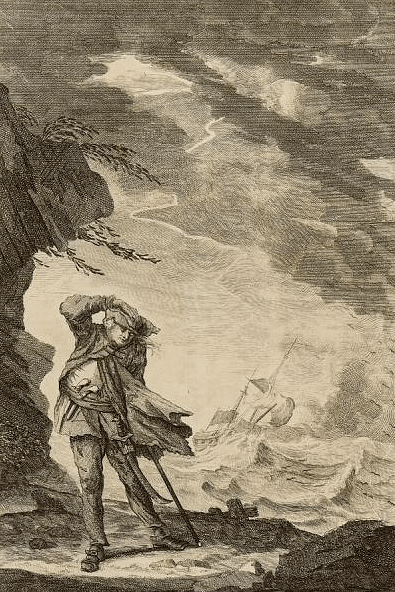
Low then seems to have become mentally unhinged. Sailing north to the colder waters off Nantucket, Low attacked a whaling sloop and, in trademark fashion, enjoyed a bit of torture on the captured captain, who was flogged, had his ears cut off, and then was shot dead. Another pair of whalers were captured soon after off Rhode Island. One captain was treated similarly but even more brutally than the Nantucket man, this time being forced to eat his own ears before being shot. A second captain had his living heart cut out, and another prisoner was forced to eat it. These gruesome episodes were reported in a Boston newspaper.
Captain Low seems to have liked fishing fleets since he continued his spree further north, attacking and capturing 23 French fishing vessels off Cape Breton. He then took a second, 22-cannon ship for his own use. In August, his fleet rose to three when Low himself took command of a 34-gun ship. By September, he was back in the Azores again and still capturing merchant vessels with impunity. Low’s fleet sailed along the coast of West Africa, but the pirate captain’s reign of terror was coming to an end.
Mutiny & Marooning
It was not the desperate authorities that masterminded Edward Low’s downfall but his own crew. The sadistic captain had unwisely begun to attack his own men. There was enough bad blood for Francis Spriggs to take one of the ships, the Batchelor’s Delight, and sail off over the horizon (he was last heard of in 1724, marooned by his crew amongst the Mosquito Indians in Honduras). Back in the Caribbean by early 1724, Low must have further upset his crew since they decided to maroon their unstable captain on a desert island. What exactly happened to Low remains something of a mystery, although one French account has him captured by a French ship and hanged in Martinique.


